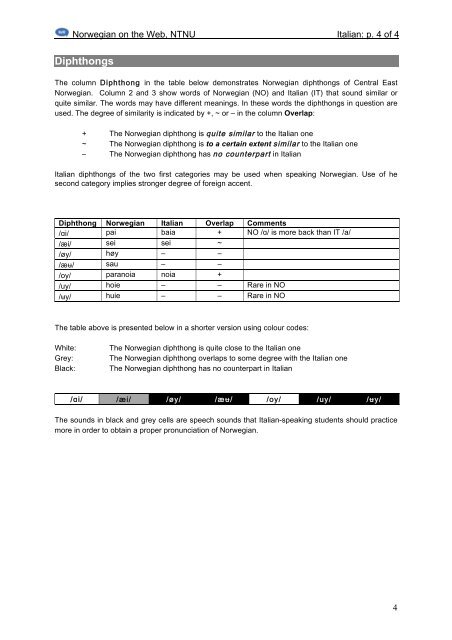Italian Norwegian - NTNU
Italian Norwegian - NTNU Italian Norwegian - NTNU
Norwegian on the Web, NTNU Italian: p. 4 of 4 Diphthongs The column Diphthong in the table below demonstrates Norwegian diphthongs of Central East Norwegian. Column 2 and 3 show words of Norwegian (NO) and Italian (IT) that sound similar or quite similar. The words may have different meanings. In these words the diphthongs in question are used. The degree of similarity is indicated by +, ~ or – in the column Overlap: + The Norwegian diphthong is quite similar to the Italian one ~ The Norwegian diphthong is to a certain extent similar to the Italian one – The Norwegian diphthong has no counterpart in Italian Italian diphthongs of the two first categories may be used when speaking Norwegian. Use of he second category implies stronger degree of foreign accent. Diphthong Norwegian Italian Overlap Comments /ɑi/ pai baia + NO /ɑ/ is more back than IT /a/ /æi/ sei sei ~ /øy/ høy – – /æʉ/ sau – – /oy/ paranoia noia + /uy/ hoie – – Rare in NO /ʉy/ huie – – Rare in NO The table above is presented below in a shorter version using colour codes: White: Grey: Black: The Norwegian diphthong is quite close to the Italian one The Norwegian diphthong overlaps to some degree with the Italian one The Norwegian diphthong has no counterpart in Italian /ɑi/ /æi/ /øy/ /æʉ/ /oy/ /uy/ /ʉy/ The sounds in black and grey cells are speech sounds that Italian-speaking students should practice more in order to obtain a proper pronunciation of Norwegian. 4
- Page 1 and 2: Norwegian on the Web Olaf Husby Nor
- Page 3: Norwegian on the Web, NTNU Italian:
<strong>Norwegian</strong> on the Web, <strong>NTNU</strong> <strong>Italian</strong>: p. 4 of 4<br />
Diphthongs<br />
The column Diphthong in the table below demonstrates <strong>Norwegian</strong> diphthongs of Central East<br />
<strong>Norwegian</strong>. Column 2 and 3 show words of <strong>Norwegian</strong> (NO) and <strong>Italian</strong> (IT) that sound similar or<br />
quite similar. The words may have different meanings. In these words the diphthongs in question are<br />
used. The degree of similarity is indicated by +, ~ or – in the column Overlap:<br />
+ The <strong>Norwegian</strong> diphthong is quite similar to the <strong>Italian</strong> one<br />
~ The <strong>Norwegian</strong> diphthong is to a certain extent similar to the <strong>Italian</strong> one<br />
– The <strong>Norwegian</strong> diphthong has no counterpart in <strong>Italian</strong><br />
<strong>Italian</strong> diphthongs of the two first categories may be used when speaking <strong>Norwegian</strong>. Use of he<br />
second category implies stronger degree of foreign accent.<br />
Diphthong <strong>Norwegian</strong> <strong>Italian</strong> Overlap Comments<br />
/ɑi/ pai baia + NO /ɑ/ is more back than IT /a/<br />
/æi/ sei sei ~<br />
/øy/ høy – –<br />
/æʉ/ sau – –<br />
/oy/ paranoia noia +<br />
/uy/ hoie – – Rare in NO<br />
/ʉy/ huie – – Rare in NO<br />
The table above is presented below in a shorter version using colour codes:<br />
White:<br />
Grey:<br />
Black:<br />
The <strong>Norwegian</strong> diphthong is quite close to the <strong>Italian</strong> one<br />
The <strong>Norwegian</strong> diphthong overlaps to some degree with the <strong>Italian</strong> one<br />
The <strong>Norwegian</strong> diphthong has no counterpart in <strong>Italian</strong><br />
/ɑi/ /æi/ /øy/ /æʉ/ /oy/ /uy/ /ʉy/<br />
The sounds in black and grey cells are speech sounds that <strong>Italian</strong>-speaking students should practice<br />
more in order to obtain a proper pronunciation of <strong>Norwegian</strong>.<br />
4



